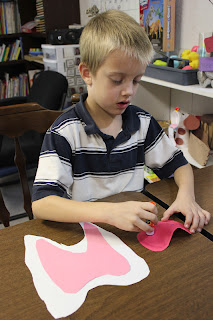Dental Care
Read:
Brushing
Teeth by
Mari Schuh, Flossing
Teeth by
Mari Schuh and At
the Dentist
by Mari Schuh
Discuss:
It is important to brush and floss your teeth every day, and visit
a dentist once a year for a check up. Show an apple. Say the apple
will be the tooth. Poke a hole into an apple and say that is what a
cavity is, a hole in your tooth.
Cavities can form when we don't
brush and floss our teeth. Let it set for a day and notice how yucky
it gets in the apple.
Show
the child how to brush the front, back, and insides of the teeth.
Then show the child how to floss each tooth properly.
Comprehension
Questions:
1.
How can we take care of our teeth? Brush, floss,
and visit the dentist
Stained
Teeth
Discuss:
Soda is bad for your teeth. It can stain them brown. You should
brush your teeth after you drink soda.
Materials:
- Hard boiled egg
- Cola
- Cup
- Old toothbrush
Directions:
- Show the hard boiled egg. Doesn't it look nice and white like our teeth? Why is there a shell around the egg? Because the shell protects the egg. Our teeth are protected by the enamel just like the egg.
- Put the egg in a cup.
- Pour in the cola.
- Let it set for at least an hour (the longer the better).
- When you take it out notice how dark it looks now. That's what happens to our teeth if we don't brush after drinking soda.
- Try to brush away the brown with an old toothbrush. It's hard to get every bit of the brown, just like it's hard to get every bit of every tooth in our mouths. We need to brush every part of every tooth every day.
Brushing
Molars
Discuss:
It is important to brush all around every tooth, not just the front
of the teeth. We discussed the Proper Way to Brush our Teeth from page 2 of this download that I found.
Materials:
- Soda Bottle
- Scissors
- White Paint
- Old Toothbrush
Directions:
- Cut off the bottom of the soda bottle.
- Paint it white to look like a molar.
- Show the child how to brush all of the tooth, not just the front where you can see.
Flossing
Teeth
Discuss:
It is important to floss your teeth to get the food that the
toothbrush can't reach.
Materials:
- Egg Carton
- Tissue Paper
- Floss
- Red Construction Paper
- Glue
Directions:
- Cut apart each section of the egg carton.
- Cut out a semi-circle from the red paper.
- Glue the egg carton sections around the round part of the red paper for the teeth.
- Stick pieces of tissue paper in between the teeth.
- Use the floss to get out the tissue paper.


































.jpg)

























